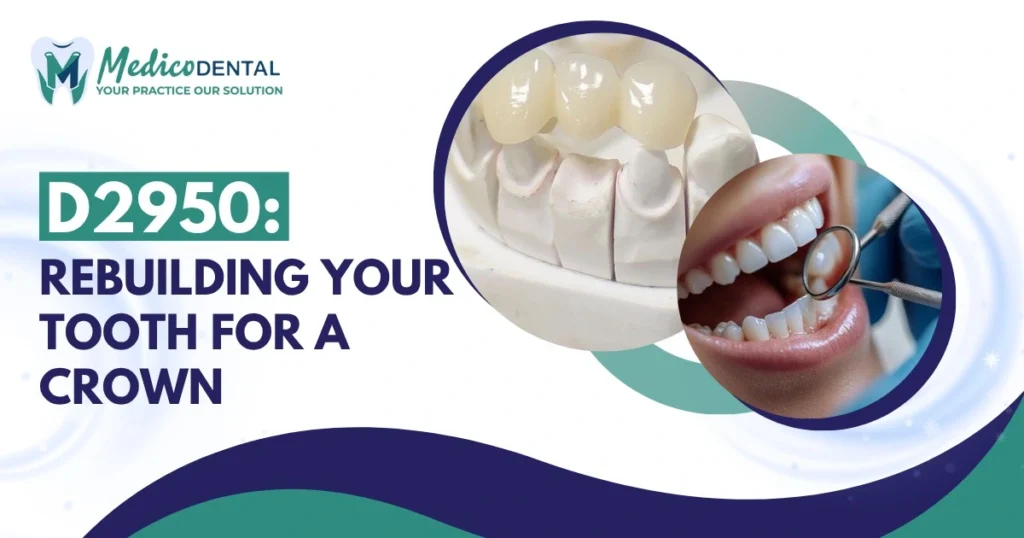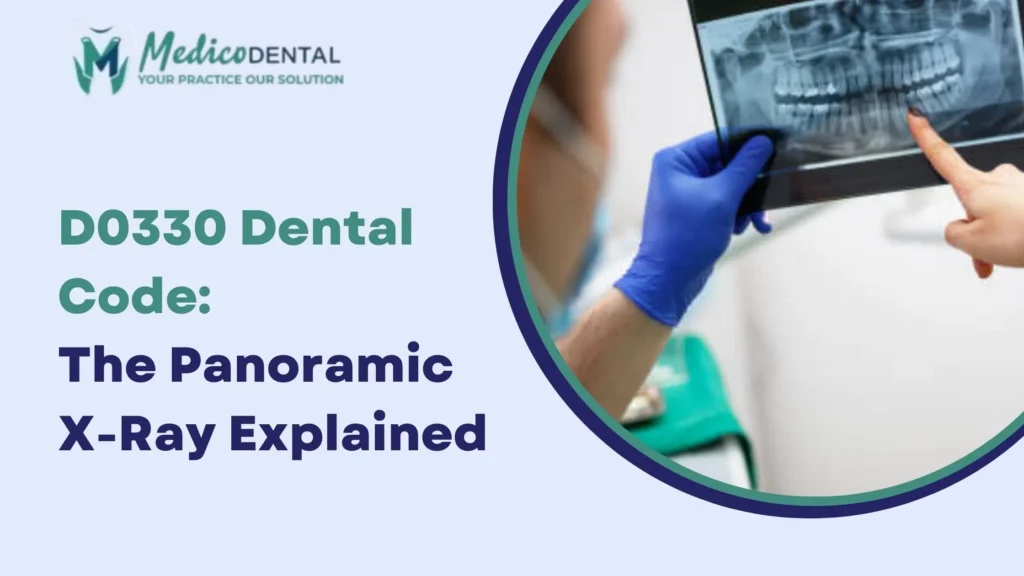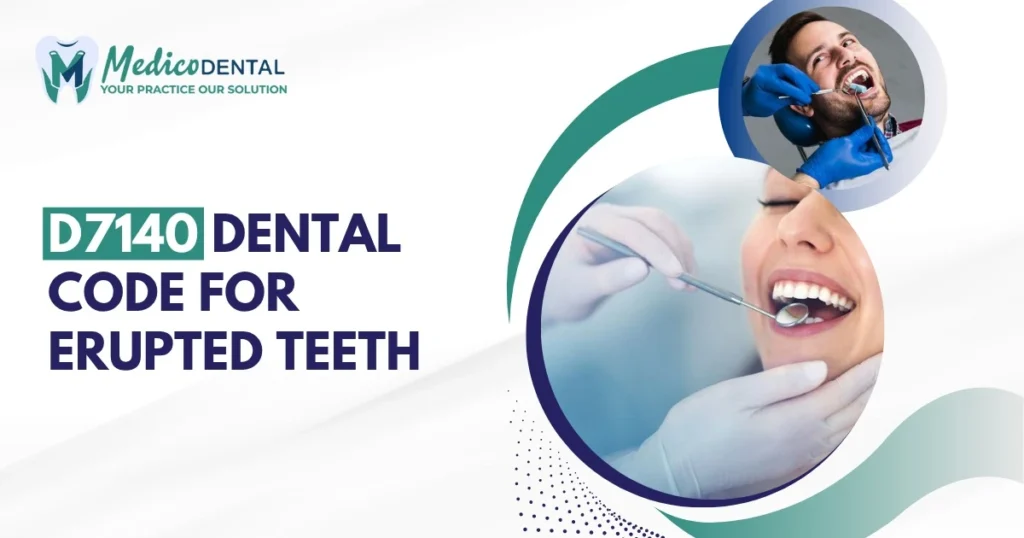When a tooth loses a large portion of its structure due to decay, trauma, or previous dental work, restoring its integrity becomes crucial before placing a crown. The CDT Code D2950 represents a procedure called core buildup, which helps rebuild the tooth’s foundation for long term stability and strength. This code ensures accurate documentation and proper insurance billing for such restorative work.
What Is CDT Code D2950?
Definition and Description
CDT Code D2950 refers to a core buildup procedure, which involves rebuilding the internal structure of a severely damaged tooth. The dentist uses restorative material to replace the missing tooth portion, creating a stable base to support a crown or bridge restoration.
When Is D2950 Used?
This code is typically used when the remaining tooth structure is insufficient to retain a crown securely. It’s often necessary after root canal therapy or when a tooth has extensive decay, fractures, or large restorations that compromise its strength.
Purpose of the Core Buildup Procedure
Restoring Tooth Strength and Structure
The core buildup procedure restores the tooth’s lost form and strength, ensuring it can withstand biting forces. It helps reinforce weakened teeth, reducing the risk of fractures or crown failure.
Preparing the Tooth for a Crown or Bridge
A crown requires a solid base for proper placement. The core buildup shapes and supports the underlying tooth, allowing the crown or bridge to fit accurately and function naturally in the patient’s bite.
Step by Step Procedure for D2950
Removal of Decay or Damage
The dentist begins by removing all decayed or compromised tooth material. This step ensures a clean and healthy surface for bonding the new restorative material.
Placement of Core Material
After cleaning the area, restorative material such as composite or amalgam is applied to rebuild the tooth’s missing portion. The material is molded to replicate the tooth’s natural contour and strength.
Use of Pins or Posts (When Necessary)
If the remaining tooth structure lacks adequate retention, the dentist may place small pins or posts to anchor the core material securely. This adds stability and ensures the restoration can support a crown effectively.
Materials Used in Core Buildup
Composite Resin
Composite resin is one of the most common materials for core buildups. It bonds directly to the tooth and can be easily shaped, offering strength and a natural appearance.
Amalgam
Amalgam, a silver colored material, is valued for its durability and longevity. It’s often used in posterior teeth where aesthetics are less critical but structural strength is essential.
Glass Ionomer or Other Materials
Glass ionomer and other hybrid materials may be chosen for their bonding ability and fluoride release. They are often used in specific clinical situations where moisture control or tooth sensitivity is a concern.
Billing and Coding Guidelines for D2950
When to Bill Separately
The D2950 code should be billed separately when the core buildup is performed independently of a crown procedure. If it’s part of the same appointment or integral to the crown prep, insurance rules may determine whether it’s reimbursable as a distinct service.
Common Billing Scenarios
Common scenarios include cases following endodontic treatment or when the existing tooth structure cannot retain a new restoration. In cases where the tooth damage resulted from a severe infection, the diagnostic information should include the appropriate ICD 10 code for a dental abscess (such as K04.6 or K04.7) alongside the D2950 procedure code to justify medical necessity for the extensive restorative work. Dentists should submit the code along with clinical notes and preoperative images for accurate claim processing.
Documentation Requirements
Accurate documentation is key to reimbursement. Dental professionals should include X rays, treatment notes, and narrative details describing the extent of tooth damage and the necessity of the core buildup.
Insurance Coverage and Limitations
When D2950 Is Covered
Most dental insurance plans cover D2950 when it’s medically necessary to support a crown or bridge. Coverage usually depends on clinical justification and proper documentation of tooth structure loss.
Common Reasons for Claim Denials
Denials often occur when the insurer determines that the procedure was unnecessary, poorly documented, or performed on a tooth without sufficient damage. Submitting incomplete notes or missing pre treatment images can also lead to rejection.
Tips to Avoid Insurance Rejections
To minimize denials, dentists should always include diagnostic images, specify why the buildup was required, and link the claim to the related crown or bridge procedure. Clear, detailed documentation ensures faster approvals and smoother claim processing.Furthermore, successful reimbursement depends on the provider being fully enrolled and approved by the payer, which highlights the critical role of timely and accurate dental credentialing for the practice.
D2950 vs. Similar Dental Codes
Understanding how D2950 differs from other restorative codes helps avoid billing confusion and ensures accurate insurance claims. Several CDT codes are related but serve distinct purposes depending on the condition of the tooth and the type of restoration required.
D2949 (Restorative Foundation)
The D2949 code is used when restorative material is placed solely to support another restoration, not to rebuild significant tooth structure. Unlike D2950, it’s typically used when the tooth still has enough structure but needs additional reinforcement before placing a filling or crown. Essentially, D2949 supports restorations, while D2950 rebuilds the core of a severely damaged tooth.
D2952 (Cast Post and Core)
The D2952 code applies when a custom cast metal post and core are fabricated in a dental lab. This option is used for teeth with very limited remaining structure, especially after root canal therapy. The cast post is cemented inside the root canal, and the core is built on top of it. It’s a more complex and costly procedure than D2950, as it involves laboratory work.
D2954 (Prefabricated Post and Core)
The D2954 code refers to using a prefabricated post inserted into the root canal and built up chairside with core material. This approach is faster and more economical than D2952 but still offers significant reinforcement. While D2950 focuses on rebuilding structure without a post, D2954 involves both post placement and buildup.
Clinical Best Practices
Following clinical best practices helps ensure that D2950 procedures are both clinically justified and properly reimbursed. These practices maintain treatment integrity and reduce the likelihood of claim denials.
Proper Case Selection
A core buildup should only be performed when there is clear evidence of substantial tooth structure loss. Dentists should evaluate whether the remaining tooth can retain a crown or if additional support is required. Proper case selection prevents unnecessary procedures and supports ethical billing.
Radiographic Evidence and Documentation
High quality X rays are vital to justify a D2950 claim. Radiographs should clearly show the loss of tooth structure or extensive damage. Along with photos and clinical notes, these records provide solid evidence for the necessity of the buildup, improving claim approval rates.
Coordination with Crown or Bridge Treatment
The core buildup should be coordinated with the subsequent crown or bridge procedure. Documenting the connection between the buildup and the final restoration ensures that the treatment is viewed as part of a comprehensive care plan rather than an isolated procedure.
Common Claim Denial Reasons for D2950
Insurance claim denials for D2950 often stem from misunderstandings about when and how the code should be applied. Recognizing these reasons helps dental offices avoid preventable rejections.
Inadequate Documentation
Insufficient documentation is the leading cause of denials. If a claim lacks clinical notes, images, or justification explaining why the buildup was needed, payers may view it as unnecessary. Clear and detailed documentation strengthens claim credibility.
Performed Without Crown Preparation
Insurance companies may deny D2950 claims if the buildup isn’t followed by a crown or bridge. The code is intended to support full restorations, not as a standalone procedure. Submitting the buildup without a related crown code can raise red flags.
Misuse of the Code for Simple Fillings
D2950 should not be used for standard fillings or minor repairs. Using it for small restorations that don’t require core support can lead to claim rejection and potential compliance issues. Always ensure the tooth’s condition justifies the use of D2950.
How to Prevent Denials and Ensure Proper Reimbursement
Proactive preparation and proper documentation can greatly reduce the risk of claim denials for D2950. Dental teams should follow standardized billing and record keeping practices to support every claim effectively.
Include Pre Treatment X rays
Preoperative X rays provide the most convincing evidence for insurance carriers. They help verify that substantial tooth structure was missing and that a buildup was clinically required. Always attach these images to the claim.
Submit Detailed Clinical Notes
Thorough clinical notes describing the procedure, tooth condition, materials used, and reasoning for the buildup help insurance reviewers understand the medical necessity. The more precise the notes, the stronger the claim.
Attach Supporting Crown Code
Since D2950 is typically performed in conjunction with a crown, linking it to the corresponding crown code (such as D2740 or D2750) is essential. This connection shows that the buildup directly supported the final restoration, improving claim validity.
Conclusion
The D2950 code plays a vital role in restoring and strengthening damaged teeth, ensuring they can properly support crowns and bridges. Understanding how and when to use it not only enhances patient care but also ensures smooth insurance reimbursement.
Key Takeaways
- D2950 is specifically for rebuilding a tooth’s core structure before crown placement.
- Accurate documentation, including X rays and notes, is essential for claim success.
- Proper code usage prevents denials and ensures compliance with insurance policies.
Importance of Accurate Coding and Documentation
Accurate coding protects both patients and providers. It guarantees fair reimbursement, reduces claim disputes, and maintains the integrity of dental records. Properly coded and documented D2950 procedures reflect a practice’s professionalism, efficiency, and commitment to ethical care.
FAQs
What does dental code D2950 mean?
Ans. CDT code D2950 refers to a core buildup procedure, which rebuilds the internal structure of a severely damaged tooth. It helps restore strength and provides a solid foundation for placing a dental crown or bridge.
When is the D2950 code used by dentists?
Ans. Dentists use the D2950 code when a tooth has lost too much structure to securely hold a crown. It’s often needed after a root canal, in cases of extensive decay, or when a large filling or fracture has weakened the tooth.
Is D2950 the same as a filling?
Ans. No. D2950 is not a regular filling. A filling repairs minor decay, while a core buildup replaces a significant portion of the tooth to support a crown. Using D2950 for a simple filling is considered incorrect coding.
What materials are used for a core buildup?
Ans. Dentists commonly use composite resin, amalgam, or glass ionomer materials for core buildups. The choice depends on the tooth’s location, remaining structure, and the patient’s individual needs.
Do dental insurance plans cover D2950?
Ans. Most insurance plans cover D2950 if it’s medically necessary to support a crown or bridge. However, coverage depends on proper documentation showing why the buildup was required and may vary by insurer.



